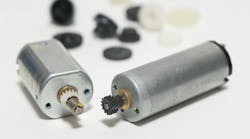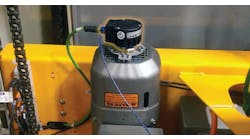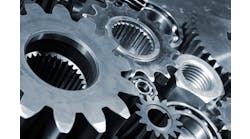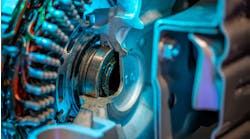Precision is a servo motor's primary advantage. The electric motor's ability to provide accuracy and control makes it ideal for industrial applications such as robotics, aerospace, automotive manufacturing, packaging machinery, textiles, material handling, semiconductors and computer numerical control (CNC).
Servo motors are electromechanical devices that provide precise positioning and acceleration using feedback and closed-loop control. They're equipped with encoders or resolvers, which provide feedback about the motor's position and speed to the control system. The closed-loop control system then compares that feedback to the desired position and velocity, making adjustments.
This precision means a servo motor can move to a specific position with great accuracy. The motor's ability to adapt to changes in position or velocity makes it a desirable device for applications where rapid adjustments are required. The control system allows the servo to operate at variable speeds, matching the requirements of the application.
A servo motor also can be connected to a programmable logic controller (PLC) or a servo controller.
How does a servo motor work?
The servo motor can generate a great amount of torque relative to its size and weight, giving it a very high torque-to-inertia rate, which makes it a solid choice for an application requiring both agility and power. It is a specialized rotary actuator, converting electrical input signals into mechanical motion.
A servo motor does not rotate continuously. Rather, it is designed and engineered for limited, controlled rotation. The motor can be ac or dc.
The servo boosts the power to the motor by sending the control-circuit signals to an amplifier to ensure it has the necessary torque to overcome resistance. The output shaft of the motor connects to the load.
Servo motors also require less maintenance and are more reliable because most are brushless, with the rotor containing the permanent magnets and the stator creating the electromagnetic field.
What is a servo motor used for?
Servo motors are well-suited for controlling robotic arms, conveyor belts, CNC machines and any manufacturing processes that require accuracy. Because of the precision needed to move robot joints and end effectors, servo motors are integral components in operations such as pick-and-place, welding and assembly. Automated warehouse systems use servos to control conveyance systems and a variety of retrieval systems. Milling machines, lathes, routers, additive-manufacturing machinery and other CNC machines regularly include servos to ensure accuracy and precision of printing, cutting or workpiece movement.
Servo motors are common in packaging equipment, such as form, fill, seal (FFS) machines or bottling systems, as well as cartoning and labeling machines, because of the need for precise product placement. The printers and label applicators also rely on servos for paper or label motion control.
Reliable control of landing gear, thrust vectoring, flaps and ailerons makes them ideal for aircraft applications. Servos can be found in camera stabilizers and gimbals and in printers that require steadiness and accuracy. And servo motors' quick-response positioning capabilities make them ideal for optimizing energy capture in wind-turbine blades, solar-panel tracking systems and other renewable-energy harvesting operations. A servo motor is also efficient at controlling heating, ventilation and air-conditioning (HVAC) valves and dampers that regulate variables.
Servo motors can be found in embroidery, knitting and weaving machines to control fabric and thread movement in textile manufacturing. Semiconductor manufacturing requires precise alignment for fabrication, thus making servo motors essential in equipment for wafer handling. And the automotive industry is filled with servo motors used in assembly lines, paint applications and welding. Servos are also common in test-and-measurement devices and injection-molding machines.
How big is a servo motor?
No standard classification exists for servo motors, but they can be categorized by frame size, torque and power output.
The National Electrical Manufacturers Association (NEMA) defines motor frame sizes but not servo-motor characteristics. While a servo motor typically comes in a frame size, such as NEMA 17, NEMA 23 or NEMA 34, indicating its physical dimensions, the performance and power characteristics vary from manufacturer to manufacturer.
NEMA ratings also apply to the electrical enclosures that contain servo motors and other components. These enclosure ratings range from dust protection (NEMA 1) to protection against, dust, dirt and oil (NEMA 13).
A servo motor's performance characteristics are usually defined by torque, measured in Nm or lb-ft, but it can come in a range of horsepower (hp) ratings. Converting the torque into hp can be done by using the following equation:
Torque (lb-ft) × speed (rpm) / 5,252 = hp
Servo motors can range from a fraction of a horsepower to several hundreds. The specific rating will depend on manufacturer specifications, which can be found on the datasheet.
Low-power servo motors can range from 1/10 hp to 5 hp, and they typically are found in smaller systems, some robotics and CNC machines.
Medium-power servos range from 5 hp to 50 hp. Larger robots, packaging machines and conveyance systems often include these medium-power motors.
Ratings greater than 50 hp define high-power servo motors. A high-power servo would be appropriate for heavy machinery, large machining centers or metal-forming equipment.
How is a servo motor different?
Servo motors' closed-loop control differs from open-loop motors, which lack feedback mechanisms. Other non-servo motors are controlled with constant voltage or current applied to the windings. They also aren't as precise as servos and usually have a fixed speed-torque, making them less versatile than servo motors. Servos, however, are typically more expensive than brushed dc motors or stepper motors because of the control system and feedback mechanism. Servo motors' cost has been decreasing, but they are still priced at a premium for operations requiring precision, accuracy and reliability.





